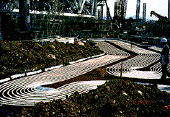 Science & Technology || Search|| Back Numbers GOING UNDERGROUND: New Thermal Storage System to Save Energy February 17, 1998 
This network of water pipes can heat and cool a building with cheaper nighttime elctricity. (Photo: Kyushu Electric Power Co.) Wide daily and seasonal fluctuations in power consumption, which have long troubled electricity providers, may soon be less of a burden. Kumamoto University and Kyushu Electric Power Co. have jointly developed a system for storing electricity obtained during cheaper late-night hours as thermal energy, making it available for climate control during the day, when power grids are often overtaxed. The storage medium for the thermal energy is common dirt, keeping installation costs as well as daytime power consumption down. Electricity providers need sufficient generation capacity to handle peak demand; increased nighttime use, by spreading consumption more evenly throughout the day, cuts down on the number of generators needed and leads therefore to reduced emissions of harmful gases like carbon dioxide. Cheap to Run, Easy to Build The new thermal-storage climate-control system is designed around the use of common soil as the heat storage medium. The first such system was installed in spring 1997 in the city of Kumamoto, Kyushu, where it is being used for the climate control of an indoor exercise ground's lounge area. Four layers of flexible 25-millimeter plastic water pipe, with a total length of 4,800 meters, are buried up to a meter beneath the earth's surface. Using electricity during late-night hours, when rates are much lower, the system adjusts the temperature of the water running through the pipe, cooling the surrounding earth to 10 degrees Celsius in the summer and heating it to 45 degrees in the winter. This latent heat energy is used to cool or heat the lounge during the daytime hours of high power usage. The system actually uses 20 to 30 percent more electricity than a standard climate-control system. But by switching its hours of power consumption from day (8:00 a.m. to 10:00 p.m.) to night (10:00 p.m. to 8:00 a.m.) under a discounted pricing scheme, the exercise ground pays only one-third to one-fourth the normal rate for the electricity it converts into thermal energy. The thermal storage system occupies about 200 square meters--the same
area as the lounge it is used to heat and cool. A wall of thermal
insulation surrounds the earth to a depth of 180 centimeters; deeper than
this, temperatures remain quite stable, negating the need for an insulating
layer at the bottom of the heat storage area. The system boasts the merit
of low installation cost, as its relatively simple structure requires no
laying of concrete or other elaborate construction techniques. Moreover,
the system occupies no more area than the space to be heated or cooled--it
can be installed directly below the building, solving problems of where to
put the climate-control unit.
The soil-based thermal-storage system, by transferring some demand to nighttime hours, is seen as a way to flatten the daytime peaks in electricity consumption and bring about more constant usage levels. This will in turn improve the efficiency of existing power plants and reduce the need for construction of new capacity--a pleasing prospect for power companies. Their customers, too, should find the system attractive for its lower power costs. Systems using cheap electricity to chill water at night and use it to cool a building during the day were first put in use back in 1952. Similar systems that freeze the water and then use the transfer of heat as the ice melts for daytime climate control have been on the market since 1995. This latter system proved a great step forward: Ice absorbs 10 times the thermal energy of liquid water for its weight, and its use made possible the miniaturization of such cooling systems. A succession of electronics manufacturers have installed ice-based thermal-storage systems in their plants. But although these units may have grown smaller, they still require space on a building's roof for installation. They also cost between 20 and 30 percent more to install than conventional air-conditioning systems. Moreover, they become a less attractive option for small- to mid-sized buildings where economies of scale cannot be brought to bear. These factors are serving to put the spotlight on the new thermal-storage climate-control system that uses dirt as its medium. With its low construction costs and minimal external space requirements, it is seen as likely to contribute to greatly expanded off-peak power consumption by smaller buildings, and to more efficient consumption in Japan as a result.  Edited by Japan Echo Inc. based on domestic
Japanese news sources. Articles presented here are offered for reference
purposes and do not necessarily represent the policy or views of the Japanese
Government. Edited by Japan Echo Inc. based on domestic
Japanese news sources. Articles presented here are offered for reference
purposes and do not necessarily represent the policy or views of the Japanese
Government.
|
